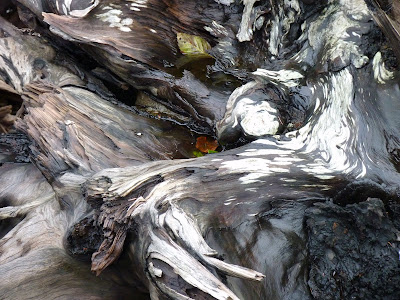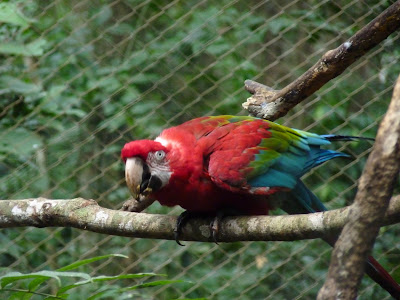I am a planner. At any given time, I am already researching 2 to 4 vacations ahead - currently, I have folders open for my next 3 vacations, through the end of 2011. Despite this, sometimes the best parts of my holiday are completely spontaneous and unexpected. That was certainly the case with the highlight of my awesome trip to Argentina.
On Wednesday morning, after two days of hiking around Iguazu National Park, I had a few hours to kill before flying back to BA in the early afternoon. I had read a post on some chat board a while back about a bird sanctuary operated by the local native group near the town of Puerto Iguazu, about 15 km from my hotel in the park, but my notes didn't specify exactly where it was. After a bit of online research by the Sheraton's concierge, we tracked down a physical street address, and I was off and running. I had absolutely no idea what to expect, but I was anxious to see some of the more elusive birds from the park up close, and figured this would likely be much more successful than wandering around some more trails hoping to have sharp enough eyes to spot these guys tucked into the treetops dozens of feet overhead.
Sure enough, the Guira Oga Wildlife Sanctuary is located about 15 minutes from the entrance to Iquazu Falls National Park, about 5 km from the town of Puerto Iguazu, and the name means "the home of the birds" in the local Quarani language.
The sanctuary is simply amazing. It is set back from the road in a corner of the rainforest. Every bird and animal here is in some way a victim of an interaction with man - either they were poached and subsequently confiscated by border patrol, or illegally kept as pets, or they were injured by a car along the length of highway that cuts through a corner of the park (a roadside sign urging motorists to slow down says 500 animals are killed each year on the highway; countless multiples are no doubt injured). The sanctuary is part rehabilitation center, part breeding center, and part zoo. Any bird or animal capable of hunting for themselves is released back into the park when they are healed; but the simple, tragic fact remains that many of these birds and animals will never be able to be released into the wild, either because they never learned to hunt or live in nature, or because their injuries will never fully heal and they would be vulnerable to attack if let loose.
There were only five of us on the 10:30 am tour, which was a shame, and I was the only anglo, which was an even bigger shame. There was a young couple from BA on their honeymoon, and a middle-aged couple from southern Argentina on a holiday in BA who'd pretty much done what I had and come up on a detour for a few days of nature. Evidently, this sanctuary is better known in the Spanish-speaking world than farther afield, but I am a big believer that it needs to be better publicized, since the entrance fee (30 pesos, or about $7.50) is how it funds its projects.
The tour is guided by a very well-informed ranger who has obviously spent considerable time working among the birds and animals. My guide, a young woman named Tamara, had been studying English for a scant 7 months, and was fluent in idiomatic English. She knew the history of each animal we observed on the two hour tour and answered a great many questions we all had. In some respects, I think the fact we were only five meant we got an even better tour, a more personalized tour, than if we'd been many.
The tour starts with all of us climbing into the back of an open bed cart being pulled along a dirt path further into the rainforest by a tractor. After about 10 minutes, it stops at a building, and we all climb down and start walking along a path which is probably a couple of kilometres long, and along which we will eventually find 15-18 large mesh domes under which groups of bird live. Toucans with toucans, eagles with eagles, parrots with parrots, etc.
The enclosures are quite large, and there are only 4-6 birds in each. Inside, the rainforest is replicated as much as possible, and there are any number of perches, etc for them to flit between. And the mesh is quite fine, which means the birds have a sense of being part of the bigger environment, while being protected from predators. I asked Tamara if the wild birds, monkeys, etc ever come out of the rainforest to investigate their brethren under mesh, and she said it happened all the time. The fine mesh also means it is possible to get really great photos without the typical fence-grid overlay which mars many a zoo shot, and the birds especially seem really curious when people come along and many came right up to the mesh to investigate us, which meant we were only five or six feet away on the pathway. They seemed to understand we were no threat to them, and that they were protected by the domes.
This is a standard green parrot:
and a scarlet macaw:
and my most favorite, the toco toucan:
It's not just birds who end up in the sanctuary - there was a family of capuchin monkeys, including this baby, and when he is old enough, he will be released back into the park, while his injured parents live out their days under protection:
The raptors, most of whom can no longer fly, spend their days outside the mesh domes, sitting on falconry posts out in the open, chattering to themselves. This is an Aquila Viuda black and white hawk-eagle, who had snapped a tendon in its wing when hit by a car. The wing had healed somewhat, but this fellow would never again have the strength to fly and more specifically, hunt:
Next to him, a Crowned Solitary Eagle:
This caiman had been a BA family's illegal pet as a baby, but when it started to grow and become aggressive, they surrendered it to the park. It is now about 12 feet long:
This is a pygmy deer. She is about the size of a border collie, which was surprising to me, being used to the full-size deer and elk of Banff and Jasper National Parks. She was having a snooze right next to the elevated walkway. Had I been so inclined, I could have easily reached over the handrail and patted her head. She was completely unfazed by the approach of people. Her babies however, stood off at a distance; born in captivity, this apprehension of people means they may eventually be released into the park.

Some of the species currently living at the sanctuary are nearly extinct in nature, their habitat destroyed by man and massive hydro electric dams along the principal rivers in the rainforest. When two or more of the same species are in the sanctuary at the same time, the rangers will try to induce mating, in order to rebuild the populations, and they take great care so the healthy babies do not become used to man or domesticated. Only by doing this do they have any hope of being able to release them into the wild when they are old enough to fend for themselves. They have apparently had great success with some species, but not others. There was an enclosure dedicated to enormous vultures, but I noticed off to the side a smaller pen with only one large black vulture sitting in it. I asked Tamara about that one. It had been found by a farmer as a fledgling, and raised in a barn before eventually being seized by officials. But the damage was already done - the vulture now only recognizes people as its "friends". The rangers tried to introduce it to the other vultures, and it attacked them as a threat. It seems incapable of recognizing its own kind, and as a result, will live out its days alone.
I never did get to see the purported highlight of the tour, however. The puma they had been caring for had recently recovered sufficiently to be released back into the park. Another success story for a well-organized and incredible sanctuary!





































